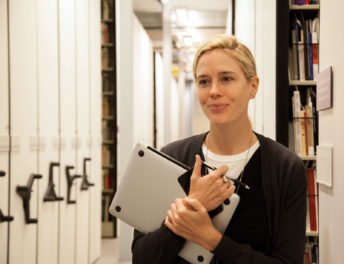
Juan Silverio, a summer intern for the Getty Research Institute’s Art and Xerography research project, uses a Xerox machine to make art.
In 1980, Jodi Stutz, a young secretary at an Illinois factory, became famous after being fired for making a photocopy of her bottom. This is one of the first stories I came across during my research as an intern for the Getty Research Institute’s Art and Xerography research project. Although that secretary wasn’t an artist, her act of transgression made clear to me how uses of the photocopier went beyond its conventional function of copying and printing documents.
The Art and Xerography project examines the impact of xerography and related electrostatic technologies on the production and distribution of art and visual culture. The Xerox Corporation introduced its photocopy machines in the early 1960s to businesses as a way to provide an instantaneous copying process to support widespread distribution. But, as Stutz’s story shows, they also became a catalyst for expression, including artistic creation and circulation. With scholars having produced only a limited amount of literature on this subject and not yet a comprehensive international study, my supervisors Zanna Gilbert and John Tain embarked on the Art and Xerography project to address that gap.
The first step was conducting extensive archival research into the GRI’s several notable collections of photocopy art, which is how I spent my summer. After concluding my time at the GRI, I’m sharing what I have learned about how the Xerox machine challenged both business and artistic conventions of technology and craft. But first, some background about the invention of the Xerox machine.
History of the Xerox Machine
In the early twentieth century, a modest scientific inventor named Chester Carlson recognized a need for efficiently and cheaply producing a copy of a document. With his lab assistant, Otto Kornei, Carlson restlessly experimented with photoconductivity, chemical powders, and paper in a small apartment a few blocks away from his home in Astoria, located in the New York City borough of Queens. In 1938, the first successful xerographic copy was a blotchy, slightly faded printed image that read: “10.-22.-38 ASTORIA.”

Text from the first xerographic image, made by Chester Carlson in 1938. Courtesy of Xerox Corporation
Following this momentous event, Carlson struggled to develop a working model and it wasn’t until 1948 that the Haloid Company, known today as Xerox Corporation, gave Carlson’s electrophotography machine a chance. Xerox then spent another two decades working through technical difficulties until creating the Xerox 914 in the 1960s and made Carlson’s dream of a simple, fully functional copy machine a reality.
Barbara T. Smith and the Early Years of Xerox Art
Artists began experimenting with photocopy machines almost immediately. One of the first to do so was Barbara T. Smith. In 1965, Smith leased a Xerox 914 machine after being turned down by a printer in Los Angeles where she had wished to make lithographs. During an eight-month period in 1965–66, Smith worked exhaustively in her dining room—printing with fabrics, objects, photographs, and her body. In her journal, Smith records, “From the first encounter I was aware of the possibility of using the Xerox machine for aesthetic purposes because of its unique qualities and capacities and the permanence of the copies. It seems evident that the verbal reproductive intent is the least impressive of its qualities, and that it has primarily a visual effect which I decided to explore.”

Some of Barbara T. Smith’s Coffins Books using a variety of bindings and materials. The Getty Research Institute, 2013.M.23
From this exploration, Smith created the Coffin Books, a series of 35 unique artist’s books, most of them bound with black covers and a silver “x” in a circle embossed on the front. The books’ resemblance to coffins is a morbid yet light-hearted metaphor for Smith, used to suggest the feelings of constraint endured by women due to sexist societal conventions.

Cover of one of Barbara T. Smith’s Coffin Books and an image from Oh! Those Leopard Skin Bikinis. The Getty Research Institute, 2013.M.23
Smith’s Coffin Book series presents a record of her experimentation with photocopying technology, though one book from this series did more than just test the technical capacities. Smith’s Oh! Those Leopard Skin Bikinis is an accordion book with plush black velvet that progresses from left to right, with Smith undressing to reveal her genitals in a prelude to masturbation. Interacting with this book felt a lot like opening a wardrobe: at every turn of a page, there was a more striking detailed image of her body.
What is compelling to me about Barbara T. Smith’s work is that it does not just reflect her extensive play with materials, but it also explores women’s sexuality and desire in a way that challenges their censorship. And while photocopying is typically associated with proliferation and public accessibility, Smith’s Coffin Books, produced in a unique set, were conceived in the privacy of her home and not intended for distribution.
The Xerox Book
Knowing that artists were challenging the conventions associated with the copy machine, I began to ask other questions. What would artists do with these pieces after producing them? How do they exist outside of the studio, in the real world? How are these photocopy works presented in an exhibition?
I found an answer in the Xerox Book, a genre that grew out of a 1968 exhibition-as-publication organized by Seth Siegelaub, and now popularly known under that title. Binding photocopy works into a book became a purposeful and popular way of exhibiting photocopy art. For example, I reviewed the Southeast Center for Contemporary Art (SECCA)’s Xerox, an eclectic selection of works by southern US artists using collage, photography, drawing, typography, and poetry. The book works both as a catalogue to SECCA’s physical exhibition, Xerox: An Exhibition of Electrostatic Images (June 22–August 19, 1984), and an exhibition in its own right.
SECCA curator Richard Craven writes in the exhibition statement that opens the book: “xerography has enabled artists to expand the perimeters of art. Images are produced almost instantaneously and as a result we are surrounded by an abundant wealth of information.” Xerox art tested the limits of the technology—its contrast, graininess, and photographic capabilities.
While handling SECCA’s Xerox catalog, I saw an array of works on paper that reflect vast experimentation. One print is a copy of a love letter written by a child and collaged with a photograph; another print depicts a grid of six Polaroid images in black and white with high contrast and text. I found this Xerox book and the idea behind it marvelous because a reader can view an entire body of work—an exhibition really—in a straightforward fashion.

Images from SECCA’s Xerox catalog, including works by (clockwise from bottom right) Mark Coburn, Jacquelyn Tait Leebrick, Marry Moor Winnet, George Brett, Steven M. Sweet, and C.B. Cooper Stratton. © 2017 Juan Silverio
The GRI Special Collections house many more Xerox books that highlight the vast experimentation done since the late 1960s. Through several organized exhibitions and publications like SECCA’s photocopied publication, xerography gained more and more visibility in the art world and in the public eye, and it became a more enticing tool for artists to make work.
Final Thoughts
I found in my research that the ubiquity, cost-effectiveness, and opportunity to experiment is what drew a lot of artists to xerography, and that the process and results are what compelled them to explore the medium further. You can make prints from objects. You can make a print of yourself. You can print multiple copies with a push of a button. You can put a photocopy back into the paper feeder and print another image over it. You can print in color, or in black and white. You can adjust the saturation, lighting, contrast, and other settings on the machine. Seeing all of these possibilities helped me understand how experimentation weaves throughout the art history of the photocopier. At every chapter in its continuing history, the photocopy machine has allowed artists to challenge artistic conventions of technology and craft.
Today the photocopier remains ubiquitous and accessible, though I no longer look at it in the same way. Knowing now the history of Chester Carlson’s resilient efforts, and the inventive creation and circulation of photocopy works, every time I see a Xerox machine, my eyes twinkle with excitement at the infinite possibilities a photocopier and I could create.
Further Reading
Alberro, Alexander. Conceptual Art and the Politics of Publicity. Massachusetts: The MIT Press, 2003.
Eichhorn, Kate. Adjusted Margin: Xerography, Art, and Activism in the Late Twentieth Century. Massachusetts: The MIT Press, 2016.
Owen, David. Copies in Seconds: How a Lone Inventor and an Unknown Company Created the Biggest Communication Breakthrough Since Gutenberg—Chester Carlson and the Birth of the Xerox Machine. New York, NY: Simon & Schuster, 2004.
Xerox Corporation. “The Story of Xerography-Xerox.” PDF File. Last modified August 9, 1999. Accessed July 11, 2017. https://www.xerox.com/downloads/usa/en/s/Storyofxerography.pdf.



Mind-expanding read, Juan! I would never have thought to think of photocopy machines this way.